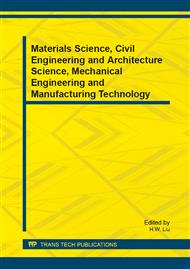p.3
p.9
p.14
p.18
p.22
p.26
p.30
p.36
Effect of Melamine / Urea Modified Phenol Formaldehyde Resin Binder on the Mechanical Properties of Glass-Fiber Felt
Abstract:
The use of melamine / urea modified phenol formaldehyde resin binder in the glass-fiber felt has led to products with lower free formaldehyde, higher water repellency and flexibility. This study gives a detailed description of the influence on the mechanical properties of the glass-fiber using the phenol formaldehyde resin with different levels of melamine and urea. Results show that, the free formaldehyde content reduced with the increase of the amount of urea and melamine, a small molecule of melamine and urea destroy the macromolecular chain of phenol formaldehyde resin leading to the decrease of breaking strength. At the same time, the decrease of the molecular chain is accompanied by the increase of flexibility.
Info:
Periodical:
Pages:
18-21
Citation:
Online since:
January 2014
Authors:
Price:
Сopyright:
© 2014 Trans Tech Publications Ltd. All Rights Reserved
Share:
Citation:


